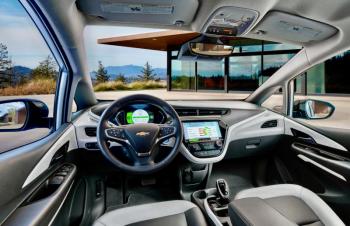The Bolt harkens back to the Volt, Chevrolet’s hybrid of 2011-19, except that the latter was a sedan with a gasoline-powered generator that charged the electric motor’s batteries while the current (get it?) car is an all-electric hatchback powered by a large battery pack that needs to be plugged in to recharge.
The Bolt arrived on a Wednesday morning with about half a “tank” remaining. I grabbed the charging cord from the trunk, ran it into the garage and plugged it into a 120-volt outlet. The driver’s screen lit up and informed me that a full charge would be achieved by 7:30 p.m. on Thursday! Right there is a powerful (get it?) argument for installing a 240-volt, 32-amp Level II fast charger in the garage, to top up the battery pack far more rapidly.
That’s what I did the next day when we arrived at the Bar Harbor Inn, which offers its guests a row of complimentary Level II charging stations. The hotel is only 77 miles from our home, but naturally I kept an eye on the instruments, which counted down the charge remaining in the batteries. No sweat—we made it with nearly 100 miles to spare. And after a perfectly normal—no, better than expected over-the-road experience.
Interestingly, the return trip seemed to be nearer 100 miles than 77, but Camden hadn’t been relocated while we slept. Instead, the air temperature was 10 degrees lower and the little Bolt was bucking wind and rain. (Maybe I was driving faster, too, since there was less traffic.) Nonetheless, having topped up the night before at the hotel, we still had an indicated 150 miles of range when we pulled into our driveway.
Really, it’s little different from driving an internal-combustion vehicle, which also consumes fuel with every mile. It’s just that, for now, “filling stations” are fewer and farther between. Well, no, there is a difference: A gas-powered car of this size and shape is typically an underpowered, noisy wheezer, but the Bolt’s 150-kilowatt electric motor delivers 200 horsepower and 266 pound-feet of instant torque, enabling it to squirt silently from 0 to 60 MPH in (Chevy claims) 6.5 seconds. Keeping up with, or outgunning, ordinary traffic is no challenge at all. Although of course a heavy foot reduces the range—again, just as in a gas-powered car.
The Volt was impressive. The Bolt is even more so—it’s small but comfortable, apparently well built, agile (the heavy batteries are in the floor, for a low center of gravity, and it’s front-wheel-drive), satisfying to operate and dead easy to get accustomed to. Battery-electric cars are far better sorted out than hybrids were when they arrived, more than 20 years ago. Unless you miss gas pumps and tailpipe emissions, there are no downsides here.
Even the price is reasonable. A basic Bolt LT starts at just $36,895, but after allowances and discounts for GM owners, Chevrolet is currently (ahem) offering it for just $28,890. The Bolt Premier, with a number of desirable add-ons, has a sticker price of $43,090 but is discounted (at least for the month of May) to $33,090. As a 2022 model, Chevrolet will soon introduce the Bolt EUV, electric utility vehicle, with the same powerplant and FWD, but 6.3 inches longer for more room and comfort in the back seats.
Welcome to the new normal.
Silvio Calabi has been reviewing cars since Ronald Reagan removed the solar panels from the White House. He lives in Camden.































